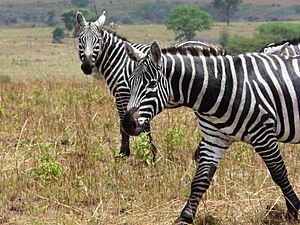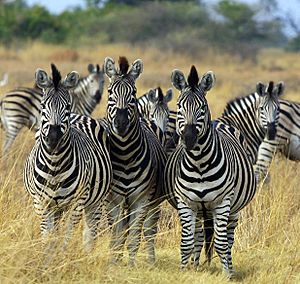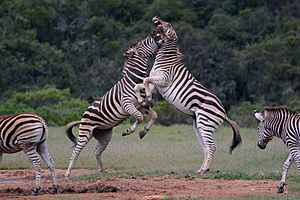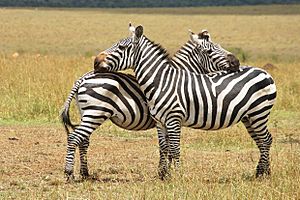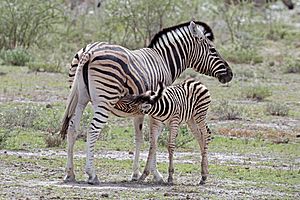Plains zebra facts for kids
Quick facts for kids Plains zebra |
|
|---|---|
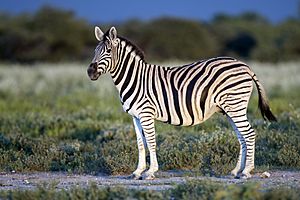 |
|
| Burchell's zebra (Equus quagga burchelli) at Etosha National Park, Namibia | |
| Conservation status | |
| Scientific classification | |
| Genus: |
Equus
|
| Species: |
quagga
|
| Subspecies | |
|
E. q. quagga † |
|
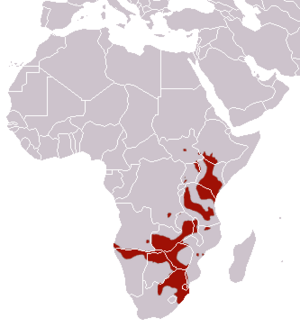 |
|
| Plains zebra range | |
| Synonyms | |
|
|
The plains zebra (also known as the common zebra) is the most widespread and common type of zebra. Its scientific name is Equus quagga. You can find them in many parts of southern and eastern Africa, south of the Sahara Desert. There used to be several types, or subspecies, of plains zebras. One of them, the quagga, is now extinct. Scientists now think that the differences between these zebras are more like gradual changes across their habitats rather than distinct subspecies.
Plains zebras are medium-sized, bigger than mountain zebras but smaller than Grévy's zebras. They usually have wider stripes than these other zebra species. Each plains zebra has its own unique stripe pattern, and these patterns can vary a lot depending on where they live. Plains zebras mostly live in open grasslands and savanna woodlands. They usually stay away from deserts, thick rainforests, and very wet areas.
Lions and spotted hyenas are the main predators of plains zebras. Nile crocodiles also hunt them near water. Less often, cheetahs and African wild dogs might hunt them, especially the young.
Plains zebras are very social animals. They live in family groups called harems, which have one male (a stallion), several females (mares), and their young. Groups of young males, called bachelor groups, also form. Many groups can come together to form large herds. Zebras watch out for predators. They bark or snort when they see danger, and the male stallion will attack predators to protect his family.
Even though plains zebras are still common in game reserves, their numbers are decreasing in many places. This is due to human activities like hunting for their meat and skin. They also face challenges from livestock competing for food and farms taking over their habitat. As of 2016, the plains zebra is considered Near Threatened by the IUCN. This means they could become endangered if their situation doesn't improve.
Contents
Understanding Plains Zebra: Classification and Types
The plains zebra was first officially named by a British zoologist, John Edward Gray, in 1824. He called it Equus burchellii. Later, in the 21st century, scientists discovered that the quagga, which was named by Pieter Boddaert in 1785, was actually the same species as the plains zebra. Because Boddaert's name was older, the plains zebra's scientific name was changed to Equus quagga.
Scientists used to think that plains zebras and mountain zebras were closely related, but recent studies (from 2013) show that plains zebras are actually more closely related to Grévy's zebras. Sometimes, plains zebras and Grévy's zebras are even seen in the same herds, and they can have fertile offspring together.
Plains Zebra Subspecies: Different Kinds of Zebras
In 2004, scientists Groves and Bell studied the skulls and coats of plains zebras. They found evidence for six different subspecies (types), listed from north to south:
- Maneless zebra, Equus quagga borensis
- Grant's zebra, Equus quagga boehmi
- Crawshay's zebra, Equus quagga crawshayi
- Chapman's zebra, Equus quagga chapmani
- Burchell's zebra, Equus quagga burchellii
- Quagga, †Equus quagga quagga (This one is extinct)
Sometimes, a seventh subspecies is also recognized:
- Selous' zebra, Equus quagga selousi
The Burchell's zebra was once thought to be extinct from hunting. However, studies showed that the original Burchell's zebra and another type were actually the same. So, the name burchellii is now used for that subspecies.
A genetic study in 2005 confirmed that the quagga was indeed the same species as the plains zebra. This study showed that quaggas had very little genetic variety. They separated from other plains zebra subspecies about 120,000 to 290,000 years ago. Their unique coat pattern might have developed quickly because they were geographically isolated or adapted to a drier environment. Also, plains zebra subspecies tend to have fewer stripes the further south they live, and the quagga lived the furthest south.
However, a 2018 DNA study found that there isn't a clear subspecies structure in plains zebras. Instead, it found a gradual genetic change from north to south. Modern plains zebra populations seem to have come from Southern Africa about 370,000 years ago. The plains zebras in Uganda, which are the most northern population, are the most genetically different.
Physical Features of Plains Zebras
Plains zebras stand about 127 to 140 centimeters (about 4 to 4.5 feet) tall at the shoulder. Their body length is about 217 to 246 cm (about 7 to 8 feet), and their tail is about 47 to 56.5 cm (about 1.5 to 2 feet) long. Males weigh between 220 and 322 kilograms (485 to 710 pounds), while females weigh 175 to 250 kg (385 to 550 pounds).
They have a sturdy body with fairly short legs. Their forehead is rounded, and their nose is slightly curved inwards. The neck of a male zebra is thicker than a female's. Their ears stand upright with rounded tips. These ears are shorter than those of mountain zebras and narrower than those of Grévy's zebras. Like all wild horses, plains zebras have a stiff mane along their neck and a tuft of hair at the end of their tail. Their body hair is quite short, about 9.4 millimeters (less than half an inch).
Zebra Stripes: Unique Patterns and Their Purpose
Like all zebras, plains zebras have bold black and white stripes. No two zebras have exactly the same pattern, making each one unique. Compared to other zebra species, plains zebras have wider stripes. The stripes are vertical on the front part of their body and become more horizontal towards their hindquarters.
Zebras living in northern areas have narrower and more distinct stripes. Zebras in southern areas have less striping on their undersides, legs, and hindquarters. Southern populations also have faint brown "shadow" stripes between the black and white stripes, which are usually missing in northern zebras. Baby zebras (foals) are born with brown and white stripes, and the brown stripes get darker as they grow older.
Scientists believe that the zebra's background color is dark, and the white stripes are an addition. The extinct quagga, which was the first subspecies described, had plain brown hindquarters with white legs, tail, and undersides. Sometimes, zebras are born with unusual coat patterns, ranging from mostly white to mostly black. Very rare albino zebras, which are mostly white, have been seen in the forests of Mount Kenya.
For over a hundred years, biologists have wondered why zebras have their bold black and white stripes. A study in 2012 suggested that stripes might help keep biting flies away. Experiments showed that the stripes reflect light in a way that discourages biting flies from landing on them. A 2014 study also supported this idea, noting that zebras live in areas with a lot of fly activity. The quagga, however, seemed to live in areas with fewer flies than other zebras. Another study in 2015 found that the temperature of the environment is a strong factor in zebra stripe patterns. This suggests that stripes might help zebras control their body temperature.
Plains Zebra Life: Habitat, Food, and Predators
Where Zebras Live: Range and Habitat
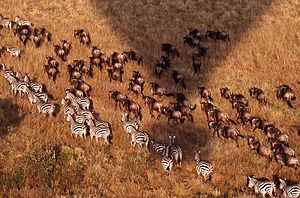
The plains zebra's home range extends across much of eastern and southern Africa, stopping just before the Sahara Desert. They live from South Sudan and southern Ethiopia, south through eastern Africa to Zambia, Mozambique, and Malawi. From there, they spread into most southern African countries.
Plains zebras usually live in open grasslands and savanna woodlands. However, they can be found in various environments, both tropical and temperate. They generally avoid deserts, dense rainforests, and areas with permanent wetlands. They prefer woodlands with acacia trees over other types of trees. Zebras need water, so they live in wetter environments than other African wild horses. They rarely travel more than 10 to 12 kilometers (6 to 7.5 miles) from a water source. Zebras can also live at high altitudes, from sea level up to 4,300 feet (1,300 meters) on Mount Kenya.
Depending on the population, zebra herds might stay in one small area, or they might migrate. Migratory zebras travel long distances between separate dry and wet season homes. When they migrate, zebras seem to remember where the best places to find food were in the past.
What Zebras Eat and Who Hunts Them
Plains zebras mainly eat grass. They prefer certain types of grass like Themeda triandra and Cynodon dactylon. During the dry season, zebras sometimes eat leaves from bushes or dig for underground plant parts like corms and rhizomes. They also seem to enjoy eating scorched leaves and twigs from certain trees.
Plains zebras are good at grazing on both long, tough grass stems and newly grown short grass. In some areas, they rarely eat grass shorter than 10 to 15 centimeters (4 to 6 inches) from the ground. They roam more widely than many other animals, even into woodlands. They are often the first grazing animals to arrive in an area with lots of plants. Their flexible upper lip helps them push plant material between their front teeth to cut it.
Zebras have a less efficient digestive system than animals like cows, but their food passes through their system twice as fast. This means zebras are not as picky about what they eat, but they spend a lot of time eating. Zebras are like "pioneer grazers"; they eat the taller, tougher grasses, which then makes it easier for other animals like blue wildebeests and Thomson's gazelles to graze on the shorter, softer grasses.
The main predators of plains zebras are lions and spotted hyenas. Lions are most successful when they hunt zebras that are alone, usually an old male. Hyenas work together to chase and separate a zebra from its group, usually a female or a foal. Nile crocodiles also hunt zebras when they are near water. Less common predators include cheetahs and African wild dogs, which mostly hunt baby zebras.
When a lion is nearby, zebras stay alert and stand in a semi-circle about 50 to 100 meters (160 to 330 feet) away. Male stallions sometimes try to scare lions away by pretending to charge them. However, zebras might approach cheetahs and wild dogs, and they allow a single hyena to come within a few meters. To escape from predators, an adult zebra can run at speeds of 60 to 70 kilometers per hour (37 to 43 mph). When hunted by hyenas or wild dogs, a zebra family group stays close together and works as a team to protect its members, especially the young. The male stallion will go on the attack to defend his family from the dogs or hyenas.
Zebra Behavior: Social Life and Communication
Plains zebras are nomadic, meaning they don't stay in one place for long, and they don't defend a specific territory. Their home ranges can vary greatly in size, from 30 square kilometers (11.5 sq mi) to 600 sq km (230 sq mi), depending on the area and if the zebras migrate. They are more active during the day and spend most of their time eating. Other activities include rolling in dust, rubbing against things, drinking, and short periods of rest. At night, zebras are quieter unless predators are nearby. They might rest or sleep lying down, while one zebra stays awake to watch for danger.
How Zebras Live Together: Social Structure
Plains zebras are very social animals. They usually live in small family groups called harems. A harem consists of one male stallion, several female mares, and their young. The adult members of a harem usually stay together for many months or even years. There are also groups of all-male "bachelors." These are stable groups of up to 15 males, with an older male usually leading. These bachelors stay in their groups until they are old enough to start their own harems. They practice for their adult roles by play-fighting and doing greeting rituals.
Many harems and bachelor groups can come together to form much larger herds, sometimes with hundreds of animals. This often happens during migrations. Plains zebras are unique among animals that live in harems because they form these large groups. Sometimes, two harems might even form temporary subgroups within a larger herd, allowing zebras to interact with those outside their immediate family. Bachelor groups tend to stay on the edges of the larger herds and follow behind when the herd moves.
Male stallions create and grow their harems by taking young mares from their birth families. When a mare becomes old enough to have babies, she attracts the attention of nearby stallions. Her family stallion (who is likely her father) will chase away or fight any stallions trying to take her. Even after a young mare is separated from her birth family, the fight over her continues until she becomes pregnant. Then, her mating partner keeps her for good, and she becomes a permanent member of his harem.
Female mares in a harem have a social order, or hierarchy. The lead female is usually the first to mate with the stallion and leads the group. When new mares join the group, the other mares might act unfriendly towards them. The male stallion has to protect the new mares until the aggression stops. The newest females usually have the lowest rank. Females who become sick or weak might lose their rank. The female members of a harem usually stay together, even if a new stallion takes over the group. When many harems gather, the male stallions might be friendly with each other, but the mares are less tolerant.
A stallion defends his harem from other males. When another male challenges him, the stallion warns the intruder by rubbing noses or shoulders. If the warning is ignored, a fight breaks out. Zebra fights can be very violent. The zebras bite each other's necks, heads, or legs, wrestle on the ground, and sometimes kick. Sometimes, a stallion might lie still on the ground as if giving up, but once the other male lets up, he strikes and continues the fight. Most fighting happens over young mares who are ready to mate. As long as a harem stallion is healthy, he usually isn't challenged. Only unhealthy stallions have their harems taken over, and even then, the new stallion takes over slowly, pushing the old one out without a big fight.
How Zebras Communicate
Scientists have recorded at least six different sounds that plains zebras make. One of their most famous sounds is a distinctive, high-pitched call, often called "barking." It sounds like "a-ha, a-ha, a-ha" or "kwa-ha, kaw-ha, ha, ha." The species name quagga comes from the Khoikhoi word for "zebra," which sounds like this call. When a zebra sees a predator, it makes a two-syllable alarm call. They make a loud snort when moving through areas where there might be danger. When they are content, a zebra makes a longer, drawn-out snort. Males make a short, high-pitched squeal when they are hurt, and foals make a long wail when they are in distress.
Zebras also use two main facial expressions: greeting and threat. In both cases, they pull back their lips and make chewing motions. When greeting, their ears stick up and point forward. When threatening, their ears are flattened down. Zebras strengthen their social bonds by grooming each other. Members of a harem gently nip and scrape along each other's neck, shoulders, and back with their teeth and lips. Mothers and foals groom each other the most, followed by siblings. Grooming helps show social status and calms down aggressive behavior.
Reproduction and Life Cycle of Plains Zebras
The pregnancy period for a zebra lasts about a year. A female mare usually gives birth to one foal every 12 months. Most births happen during the rainy season. A mare gives birth near her group while lying on her side. The newborn foal weighs about 30 to 35 kilograms (66 to 77 pounds). The afterbirth is rarely eaten.
A newborn foal can stand almost immediately after birth and starts eating grass within a week. Right after birth, a mother zebra keeps all other zebras away from her foal, including the stallion, other mares, and even her older offspring. Later, however, they all bond as a group. Within the group, a foal has the same social rank as its mother. The male stallion is generally not tolerant of foals that are not his own, and sometimes these young foals may be killed.
Many foals die in their first year, usually because of predators. However, baby zebras are protected more than the young of other animals like wildebeest. A foal is usually weaned (stops drinking milk) at around 11 months, but it might continue to suckle for longer. Females can start having babies at 2.5 years old, while males are ready at 5 to 6 years old. Young male zebras eventually leave their family groups as their bond with their mothers weakens after a new sibling is born. The young stallion then looks for other young stallions to join. Young females might stay in their harem until another stallion takes them to join his own harem.
Plains Zebras and Humans
Conservation Efforts
In 2016, the plains zebra was listed as Near Threatened by the IUCN. As of that year, there were an estimated 500,000 plains zebras in total. The species is still common in its range, but its population has decreased in 10 out of the 17 countries where it lives. Their numbers are stable in Ethiopia, Malawi, and South Africa, and possibly Angola. They are stable or increasing in Mozambique, Namibia, and Swaziland. However, their numbers are decreasing in Botswana, DR Congo, Kenya, Rwanda, Somalia, South Sudan, Tanzania, Uganda, Zambia, and Zimbabwe. Plains zebras are now extinct in Burundi, Lesotho, and possibly Somalia.
Zebras are threatened by hunting for their hide and meat. Their habitat is also changing due to farming. They also compete with farm animals for food, and fences block their migration routes. Wars in some countries have also caused zebra populations to decline. Luckily, zebras can be found in many protected areas across their range. These include Serengeti National Park in Tanzania, Tsavo and Masai Mara in Kenya, Hwange National Park in Zimbabwe, Etosha National Park in Namibia, and Kruger National Park in South Africa. Some stable populations also live in areas that are not protected.
The quagga, an extinct subspecies of plains zebra, was hunted by early Dutch settlers and later by Afrikaners. They hunted quaggas for their meat or their skins, which were traded or used locally. The quagga was likely vulnerable to extinction because it lived in a limited area and may have competed with farm animals for food. The last known wild quagga died in 1878. The last quagga in captivity, a female in Amsterdam's Natura Artis Magistra zoo, died on August 12, 1883. In 1984, the quagga was the first extinct animal to have its DNA studied. The Quagga Project is now trying to bring back the quagga's appearance by carefully breeding Burchell's zebras.
Zebras in Culture
Zebras have been important in African art and culture for thousands of years. They have been shown in rock art in Southern Africa (modern Botswana, Namibia, and South Africa) that dates back 20,000 to 28,000 years. However, they are not as common in this art as antelope species like the eland. How the zebra got its stripes has been the subject of folk tales, some of which say it was scorched by fire. The San people connected zebra stripes with water, rain, and lightning because of their dazzling pattern.

The plains zebra is the national animal of the Republic of Botswana. Its stripes are shown on the country's flag. The flag stripes also represent different races living together peacefully in the country. Botswana's national football team is nicknamed 'The Zebras' and often wears striped jerseys that look like zebra stripes.
The zebra has also been a symbol in Western culture. They have been seen as a more exotic choice than horses. For example, the comic book character Sheena, Queen of the Jungle is shown riding a zebra. The movie Racing Stripes features a zebra that is an outcast from horses and ends up being ridden by a rebellious girl. In the film Fantasia, two centaurs are shown as half-human and half-zebra, instead of the usual half-human and half-horse. Zebras have also been characters in other animated films like Khumba, The Lion King, and the Madagascar films.
Images for kids
See also
 In Spanish: Cebra común para niños
In Spanish: Cebra común para niños



